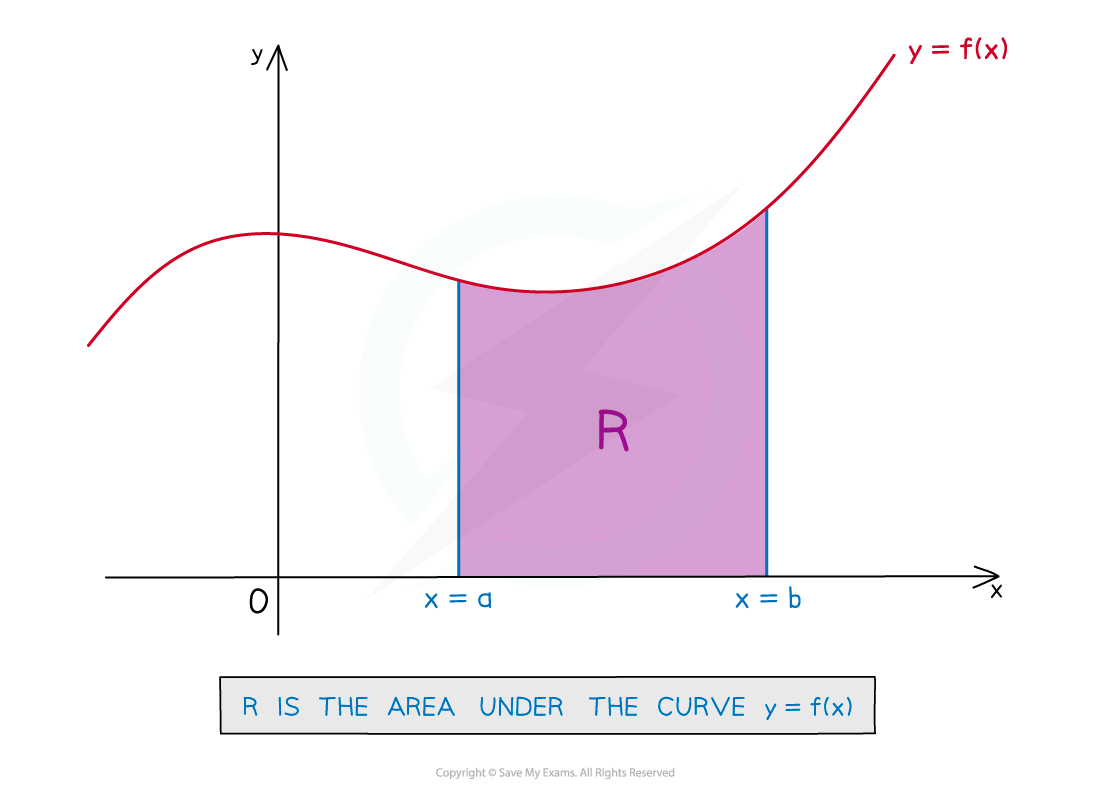Finding Areas Using a GDC (DP IB Applications & Interpretation (AI)): Revision Note
Did this video help you?
Area under a curve basics
What is meant by the area under a curve?

The phrase “area under a curve” refers to the area bounded by
the graph of
the
-axis
the vertical line
the vertical line
The exact area under a curve is found by evaluating a definite integral
The graph of
could be a straight line
The use of integration described below would still work
But the shape created would be a triangle, rectangle or trapezoid
It is easier then to use the relevant geometric area formulas
What is a definite integral?
A definite integral is written in the form
, where
is the integrand (function to be integrated)
and
are the integration limits
is the lower limit, and
is the upper limit
These correspond to the lines
and
in the area under a curve
According to the Fundamental Theorem of Calculus, if
is an antiderivative of
, then
The constant of integration (“
”) is not needed in definite integration
"
” would appear alongside both F(a) and F(b)
Then subtracting means the “
”’s would cancel
How do I form a definite integral to find the area under a curve?
The graph of
and the
-axis should be obvious boundaries for the area
So the key here is in finding
and
, the lower and upper limits of the integral
STEP 1
Use the given sketch to help locate the limits
You may prefer to plot the graph on your GDC and find the limits from there
STEP 2
Look carefully where the ‘left’ and ‘right’ boundaries of the area lie
If the boundaries are vertical lines, the limits will come directly from their equations
Look out for the
-axis being one of the (vertical) boundaries – in this case the limit will be
One, or both, of the limits, could be a root of the equation
i.e. where the graph of
crosses the
-axis
In this case solve the equation
to find the limit(s)
A GDC will solve this equation, either from the graphing screen or the equation solver
STEP 3
The definite integral for finding the area can now be set up in the form
Examiner Tips and Tricks
Look out for questions that ask you to find an indefinite integral in one part (so “+c” needed), then in a later part use the same integral as a definite integral (where “+c” is not needed).
Examiner Tips and Tricks
Add information to any diagram provided in the question, as well as axes intercepts and values of integration limits.
Mark and shade the area you’re trying to find, and if no diagram is provided, sketch one!
Did this video help you?
Definite integrals using GDC
Does my calculator/GDC do definite integrals?
Modern graphic calculators (and some ‘advanced’ scientific calculators) have the functionality to evaluate definite integrals
i.e. they can calculate the area under a curve (see above)
If a calculator has a button for evaluating definite integrals it will look something like
This may be a physical button or accessed via an on-screen menu
Some GDCs may have the ability to find the area under a curve from the graphing screen
Be careful with any calculator/GDC
They may give you a decimal approximation rather than an exact answer
E.g. 3.141592654 instead of
How do I use my GDC to find definite integrals?
Without graphing first...
Once you know the definite integral function your calculator will need three things in order to evaluate it
The function to be integrated (integrand),
The lower limit (
from
)
The upper limit (
from
)
Have a play with the order in which your calculator expects these to be entered – some do not always work left to right as it appears on screen!
With graphing first...
Plot the graph of
You may also wish to plot the vertical lines
and
For the vertical lines, make sure your GDC is expecting an "
" style equation
Once you have plotted the graph you need to look for an option regarding “area” or a physical button
It may appear as the integral symbol (e.g.
)
Your GDC may allow you to select the lower and upper limits by moving a cursor along the curve - however this may not be very accurate
Your GDC may allow you to type the exact limits required from the keypad
Examiner Tips and Tricks
When revising for your exams, practise using your GDC to evaluate definite integrals (or to check any definite integrals you may have calculated by hand).
This will ensure you are confident using the calculator you plan to take into the exam, and should also get you into the habit of using you GDC to check your work, something you should do if possible.
Worked Example
a) Using your GDC to help, or otherwise, sketch the graphs of
,
and
on the same diagram
Answer:

b) The area enclosed by the three graphs from part (a) and the -axis is to be found.
Write down an integral that would find this area.
Answer:

c) Using your GDC, or otherwise, find the exact area described in part (b).
Give your answer in the form where
and
are integers.
Answer:


Unlock more, it's free!
Did this page help you?